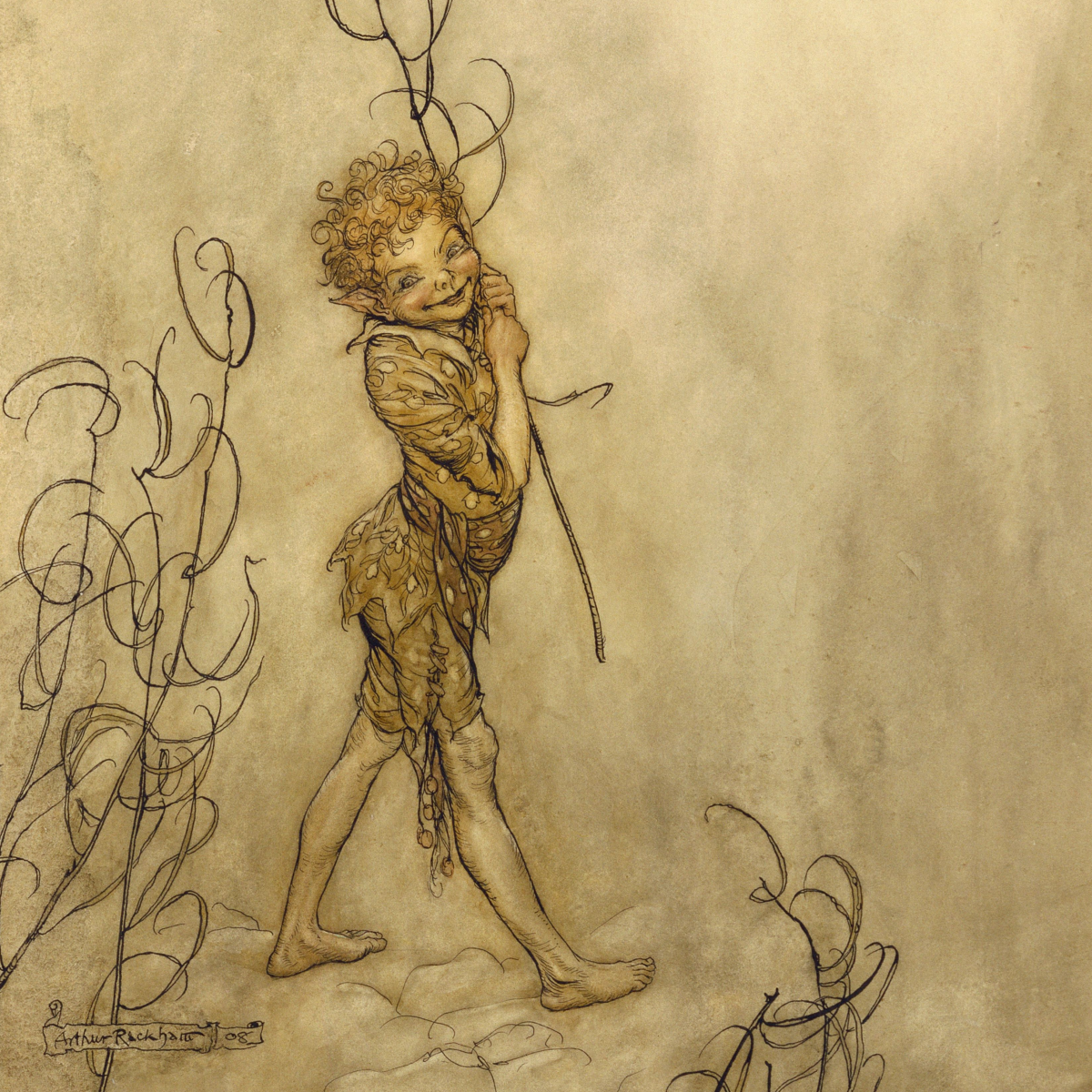For the novel I’m working on, I’ve been incorporating faerie folklore into the plot, characters, and worldbuilding. There are many different ways a writer might draw from folklore—by adapting tales to create a new story, by using folklore motifs to deepen the plot, by incorporating folkloric creatures as characters—the possibilities are endless.
Shakespeare and Faerie Folklore
Writers have been incorporating faerie folklore into literature for hundreds of years. One of my favorite early works that includes faerie folklore is A Midsummer Night’s Dream by William Shakespeare. If you aren’t familiar with the play, it was first published in 1600 and is a comedy that explores the ups and downs of love. Shakespeare juxtaposes the human desire for well-matched love with faerie mischief-making, but (mostly) resolves all of the comedic antics by the end of the play with the marriage of three different couples.
Shakespeare lived at a time when faerie belief and folktales would have been a part of the fabric of society where he grew up in Stratford-upon-Avon. It’s thought that he drew from this knowledge as well as from any faerie literature that he might have read.
I want to put forth a small note on faerie folklore in general: I use the term in a broad sense as described by Katharine Briggs in An Encyclopedia of Fairies: Hobgoblins, Brownies, Bogies, and Other Supernatural Creatures. She writes that faerie lore can “… cover that whole area of the supernatural which is not claimed by angels, devils or ghosts.” In this way brownies, hobgoblins, merpeople, nursery bogies, etc., are included within faerie folklore.
A Character Plucked from Traditional Folklore
Indeed, the faeries in A Midsummer Night’s Dream are varied, and many of them display a combination of traits that come from both folklore and faerie literature. Kenneth Muir explains in the article, “Folklore and Shakespeare,” that Shakespeare often employed a “… method of combining literary and folk-material.” But one faerie in A Midsummer Night’s Dream stands out—Puck, also known as Robin Goodfellow. Muir writes, “Puck is … the only character who is entirely traditional. He is the Pouke of folklore, Robin Goodfellow and Lob [another term for hobgoblin].”
Puck is not a character invented by Shakespeare, but rather comes from English and Welsh folklore tradition. Katharine Briggs, in An Encyclopedia of Fairies: Hobgoblins, Brownies, Bogies, and Other Supernatural Creatures, explains that “In medieval times, ‘Pouk’ [another name for “Puck” and another spelling of “Pouke”] was a name for the Devil. … By the 16th century, however, Pouk had become a harmless trickster, ….”

Puck as a Hobgoblin and a Brownie
Puck was a hobgoblin, a creature who was “… on the whole, good-humoured and ready to be helpful, but fond of practical joking, ….” And, as a hobgoblin, he was capable of shape-shifting—he often played pranks on unsuspecting folk for his own entertainment. In A Midsummer Night’s Dream, Puck (or Robin Goodfellow depending on the edition of the play you look at) describes himself to another faerie, which provides an excellent portrayal of a tricksy hobgoblin:
I am that merry wanderer of the night. I jest to Oberon and make him smile When I a fat and bean-fed horse beguile, Neighing in likeness of a filly foal. And sometime lurk I in a gossip’s bowl In very likeness of a roasted crab, And, when she drinks, against her lips I bob And on her withered dewlap pour the ale. The wisest aunt, telling the saddest tale, Sometime for three-foot stool mistaketh me; Then slip I from her bum, down topples she And “Tailor!” cries and falls into a cough, And then the whole choir hold their hips and loffe And waxen in their mirth and neeze and swear A merrier hour was never wasted there. (Act 2: Scene 1: 45-59)
Puck shape-shifts and makes sport at the expense of others, thoroughly enjoying himself. Yet Briggs reminds us that Puck wasn’t all tricks and jests—he had a helpful side, much like a brownie coming out at night and performing labor for humans. The faerie mentioned above observes this trait as she speaks to Puck:
Those that “Hobgoblin” call you and “sweet Puck,” You do their work, and they shall have good luck. (Act 2: Scene 1: 41-42)
The faerie exposes Puck’s softer nature in being helpful by doing work for people. Additionally, toward the end of the play, once the three newlywed couples are off to bed, the faeries plan to sing and dance through the palace, blessing the lovers while they sleep. Puck enters first saying:
I am sent with broom before, To sweep the dust behind the door. (Act 5: Scene 1: 406-407)
Now that it is night and faerie time, Puck is perhaps there to clean up a bit after the wedding festivities and prepare the palace for the faeries’ arrival (which includes the king and queen of the faeries), further revealing his brownie-like attributes.
Pwca: Welsh Folklore Related to Puck
It is also thought that Shakespeare drew his folklore inspiration from Pwca, which was the Welsh version of Puck. Wirt Sikes, in his British Goblins: Welsh Folk-lore, Fairy Mythology, Legends and Traditions, explains that there is a tradition of belief that Shakespeare “… received his knowledge of the Cambrian [Welsh] fairies from his friend Richard Price, son of Sir John Price, of the priory of Brecon.”
Pwca, like the English Puck, was known to be a Will o’ the Wisp (Ellylldan in Welsh), playing tricks on night travelers by leading them down narrow paths, into bogs, or up to the edge of a ravine. Sikes points to the following passage from Act 3, where Puck speaks, and his self-description resonates with stories of Pwca:
I’ll follow you. I’ll lead you about a round,
Through bog, through bush, through brake,
through brier.
Sometime a horse I’ll be, sometime a hound,
A hog, a headless bear, sometime a fire,
And neigh and bark and grunt and roar and burn,
Like horse, hound, hog, bear, fire, at every turn.
(Act 3: Scene 1: 107-113)
By changing his physical appearance, he claims he’ll be able to mislead others, similar to how Pwca would. Most descriptions of Puck focus on his mischievous attributes, and I found very little in the way of physical features (perhaps because he’s a shape-shifter?). Sikes does include a picture of Pwca in his book, drawn with a piece of coal by someone in Wales (no attribution is given). He looks a bit like a fledgling bird, but Sikes writes that “… Pwca has a sufficiently grotesque elfish aspect.”

Shakespeare’s Contribution to Puck
While Shakespeare looked to faerie folklore for most of his inspiration for Puck’s character, he did provide Puck with something unique: a proper name. Both Briggs and Sikes credit Shakespeare with this. Puck originally was a term like “hobgoblin” and was a type of English faerie, with many “pucks” running around playing tricks. But Shakespeare gave him individuality, and now the name “Puck” belongs to him alone.
Art credit (featured image): Puck – “Lord what fools these mortals be” by Arthur Rackham via Folger Shakespeare Library Digital Collections, licensed under CC0




